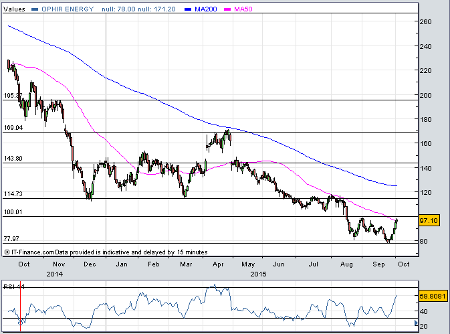Share of the week: Less reason to fear Ophir
2nd October 2015 17:00
by Harriet Mann from interactive investor
Share on
The world's first small-scale floating liquefied natural gas (FLNG) project was given the final go-ahead this week, giving French exploration and production firm Perenco the green light to use the revolutionary technology to target millions of tonnes of gas in Cameroon.
The project's progression proves there is still demand for LNG, despite a supply glut. The Cameroon FLNG is very similar to the platform is trying to get off the ground, and shares in the FTSE 250 firm bounced from last week's record lows in response.
The French explorer is using the same vessel provider, liquefaction technology and even a similar tolling fee arrangement to Ophir, which only bolsters the credentials of the London-listed explorer's proposal. Perenco will likely have to work harder to be profitable, however, with its breakeven cost of $80.2/Mbtu (million British thermal units) roughly $0.60/mmbtu higher than Ophir's Equatorial Guinea project.
"That Perenco, a similarly 'inexperienced' LNG player, has secured gas sales agreements suggests latent long-term demand in our view, in spite of the perceive supply glut and with spot prices attractive to buyers," says UBS analyst Daniel Ekstein.

(Click to enlarge)
With global LNG demand expected to surge by 80% to 430 million tonnes per annum (mtpa) by 2025, oversupply should not be an issue as Barclays reckons only 21% of the expected post-2018 capacity additions have passed the planning phase. Although a "modest" surplus of 6% is forecast over the next decade, this isn't a glut, say the analysts.
The floating platform will give Ophir better access to the 2.2 million tonnes per annum (mtpa) of gas locked in the offshore fields of Equatorial Guinea, which would otherwise be too expensive to develop. Although Perenco's is the first small scale FLNG project, Shell is using the revolutionary technology to access up to 3.6 million tonnes of LNG each year from the Prelude field.
Ophit has spent around $600 million on the project already, so the Perenco deal should ease some investor nerves over the wider industry backdrop. But the market is still doubting whether Ophir can attract the big upstream partners and gas buyers it needs to progress further, warns Ekstein. But with its upstream Front End Engineering and Design (FEED) contracts awarded and a midstream partner found in Golar LNG, the likelihood of getting first gas in mid-2019 isn't too much of a stretch.
So, Ophir's investment case is centred around its industry transactions, but Barclays is optimistic, citing its cash rich balance sheet, the progress already made at Fortuna and its current valuation. With the commodities rout leaving the exploration and production sector in tatters, at least Ophir can benefit from declining costs.
Thanks to this week's stellar performance, Ophir has bounced from 78p, ending the week at 97p. Yet the shares are still worth 57% less than this time last year.
"The recent sector sell-off leaves Ophir very much in the option value territory, in our view," explains Ekstein, maintaining his 120p target price and 'buy' rating. Shareholders will have to wait until 2016 for any profits, however, and even then they will be small. Barclays forecasts pre-tax losses of £143 million this year, with 2016's £22 million profit falling to £15 million in 2017.
This article is for information and discussion purposes only and does not form a recommendation to invest or otherwise. The value of an investment may fall. The investments referred to in this article may not be suitable for all investors, and if in doubt, an investor should seek advice from a qualified investment adviser.